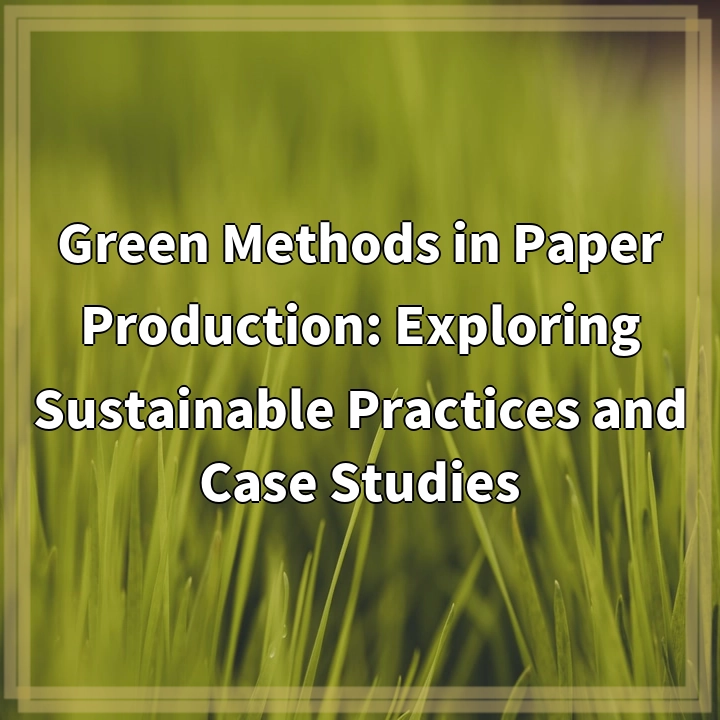
What it is:
Green methods in paper production refer to sustainable practices that aim to minimize the environmental impact of the papermaking process. These methods prioritize the efficient use of resources, reduction of greenhouse gas emissions, and protection of natural habitats. By implementing eco-friendly techniques, the paper industry can contribute to biodiversity conservation, combat climate change, and improve overall sustainability.
Real-world problems:
Despite efforts to adopt greener methods, the paper production industry still faces several challenges. These problems arise from the extensive demand for paper products and the inherently resource-intensive nature of papermaking. Some of the key issues associated with paper production include the following:
1. Deforestation:
One of the major concerns is the depletion of forests due to the sourcing of raw materials for paper manufacturing. The extraction of wood fibers from trees, particularly when unsustainable practices are employed, can lead to habitat destruction, loss of biodiversity, and disruption of local ecosystems.
2. Water consumption:
The paper production process requires a substantial amount of water for various stages, including pulp preparation, washing, and bleaching. Excessive water usage not only depletes freshwater resources but also results in the release of wastewater containing harmful chemicals into rivers and streams, causing pollution and threatening aquatic life.
3. Energy consumption and carbon emissions:
Traditional paper mills rely heavily on fossil fuels, contributing to greenhouse gas emissions and exacerbating climate change. The high energy demand for pulping, drying, and transportation processes contributes to the industry’s carbon footprint. Finding alternative energy sources and implementing energy-efficient technologies are crucial steps towards reducing these emissions.
4. Recycling and waste management:
The proper management of paper waste is essential for minimizing environmental impact. Insufficient recycling efforts and improper disposal of paper products can lead to landfills overflowing with non-biodegradable waste, further adding to pollution and contributing to the depletion of natural resources.
While these real-world problems pose significant challenges, the paper production industry is actively exploring sustainable practices and adopting innovative technologies to mitigate these issues. Through the implementation of green methods, such as responsible sourcing of raw materials, water conservation measures, renewable energy utilization, and improved waste management, the industry is working towards a more sustainable future for paper production.

Summary of Solutions:
Addressing the real-world problems associated with green methods in paper production requires the implementation of various solutions. By adopting these solutions, the paper industry can significantly reduce its environmental impact and move towards a more sustainable future.
1. Sustainable sourcing:
Implementing responsible sourcing practices is crucial to combat deforestation. This involves seeking certification from organizations like the Forest Stewardship Council (FSC) to ensure that wood fibers are obtained from sustainably managed forests or from alternative sources like agricultural residues and recycled materials.
2. Water conservation:
Reducing water consumption in the paper production process is essential. Implementing closed-loop systems, optimizing water usage through recycling and reusing, and implementing advanced technologies like water-saving equipment can help minimize water wastage and decrease pollution from wastewater discharge.
3. Renewable energy utilization:
Transitioning from fossil fuels to renewable energy sources can significantly reduce carbon emissions. Investing in and utilizing solar, wind, or hydroelectric power for energy-intensive processes in paper mills can help mitigate the environmental impact and contribute to decreased greenhouse gas emissions.
4. Waste management and recycling:
Efficient waste management and increased recycling efforts are crucial in minimizing the amount of paper waste ending up in landfills. Implementing recycling programs, promoting the use of recycled paper products, and investing in technologies for paper de-inking and pulp recycling can help close the loop and reduce the need for virgin materials.
By implementing these solutions, the paper production industry can contribute to the preservation of forests, reduce water consumption, decrease carbon emissions, and promote the circular economy. These efforts are essential for ensuring the sustainability of the paper industry while preserving our natural resources for future generations.















